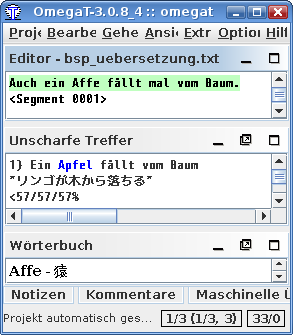Comprehensive texts are translated using the OmegaT software — a computer-aided translation program for professional translators.
CAT Software
OmegaT is a so-called CAT (Computer Aided Translation) software and stores translations in a TMS (Translation Memory System). At the same time OmegaT uses TMS data from projects of previous translations. The use of OmegaT is particularly suitable for large texts with a large number of repetitions and / or texts for which a previous version has already been translated.
OmegaT is NOT a automatic computer translation program. Rather, the software stores translations used by the translator and uses them to provide the translator with suggestions for translating new texts.
Translation
At the beginning of a translation, the source text to be translated (individual files or complete directory trees) is imported into OmegaT. OmegaT then splits this source text into segments (sentences, headings, bulleted lists, etc.).
These segments are then offered to the translator for processing in pairs of source and target languages. OmegaT stores the translation of source and target text in its internal TMS and applies this translation to subsequent identical segments of the source code.
Terminology
For the consistency of translations the use of a terminology management is important. This ensures that the same translation is used for identical terms in different documents. OmegaT uses glossaries that contain translations of individual terms or phrases.
An OmegaT glossary is a bilingual dictionary for individual terms or phrases of specific subject areas. While working with OmegaT, it constantly displays entries in the current glossary for the words of a segment being edited by the translator.
Usage
OmegaT is ideal for translating recent versions (updates) of documents. On the one hand, there is the situation that a sentence from an earlier version is identical to a sentence from the text currently being translated. This is automatically displayed to the translator by OmegaT for review and can be used by the translator to translate the current sentence.
On the other hand, there is the situation where a sentence from an earlier version is PARTIALLY identical to a sentence from the text currently being translated. This too is automatically displayed to the translator for review. He can then decide if and if so which existing translation should be used for the translation of the new sentence.

Furuno-Schiele Translations © 2024 | info@Furuno-Schiele.de | Imprint | Data protection